Tras años construyendo sitios web con WordPress, hemos aprendido lo importante que es tener una configuración local de WordPress en tu ordenador.
Tener WordPress en tu máquina personal te permite experimentar con nuevas funciones sin poner en riesgo tu sitio web, profundizar en el desarrollo de WordPress e incluso crear sitios web completos antes de que salgan a la luz. Es como tener una caja de arena privada para todos tus proyectos de WordPress.
Si eres usuario de Windows, existen numerosas formas de configurar WordPress localmente. Pero lo hemos reducido a los dos métodos más sencillos. En esta guía, te mostraremos cómo instalar WordPress fácilmente en un ordenador con Windows, independientemente de la versión que estés utilizando.
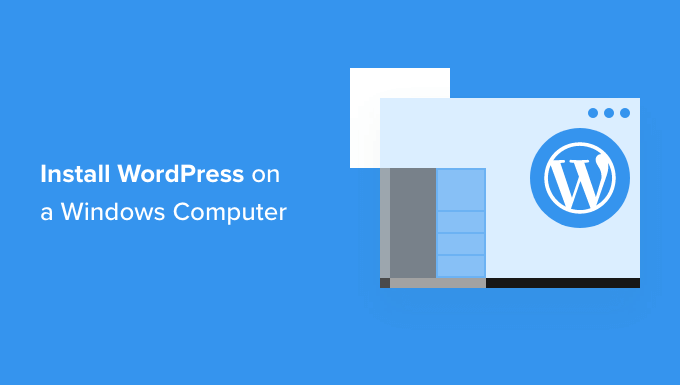
¿Por qué debería instalar WordPress en Windows?
Si eres usuario de Windows, instalar WordPress localmente en tu ordenador te ofrece varias ventajas.
Una instalación local de WordPress crea un entorno de pruebas que no afecta a su sitio web. Esta configuración, a menudo llamada servidor local o localhost, es tu patio de recreo personal para WordPress.
Los desarrolladores de WordPress utilizan habitualmente instalaciones locales para su trabajo. Por ejemplo, pueden utilizarla para experimentar con nuevos plugins o temas o probar el sitio antes de actualizarlo al editor de bloques Gutenberg.
Pero no es sólo para los profesionales. Si eres nuevo en WordPress, una configuración local es perfecta para aprender. Puedes explorar funciones, probar temas y plugins, y experimentar libremente sin preocuparte de romper un sitio activo.
Es importante tener en cuenta que cuando instalas WordPress localmente en Windows, sólo tú puedes ver el sitio. Si quieres crear un sitio web público, necesitarás un nombre de dominio y alojamiento web.
Ahora, técnicamente, puedes instalar WordPress en Windows usando XAMPP, y hemos escrito un tutorial sobre ello antes.
Dicho esto, hemos encontrado 2 formas aún más sencillas que XAMPP para configurar un entorno local de WordPress, por lo que son ideales para principiantes o usuarios que necesitan crear un sitio local rápidamente. Puedes hacer clic en el enlace de abajo para saltar al método que te interese:
Método 1: Instalar WordPress en Windows con Studio (rápido y sencillo)
Para el primer método, utilizaremos Studio. Es un software local de WordPress hecho por Automattic, la empresa que gestiona y dirige WordPress.com, que es un constructor de sitios web basado en el software de WordPress.
Hablaremos primero de este método porque es mucho más rápido y sencillo de seguir, lo que lo hace perfecto para los principiantes.
En primer lugar, tienes que abrir el sitio web Studio by WordPress.com. A continuación, haz clic en el botón “Descargar para Windows”.
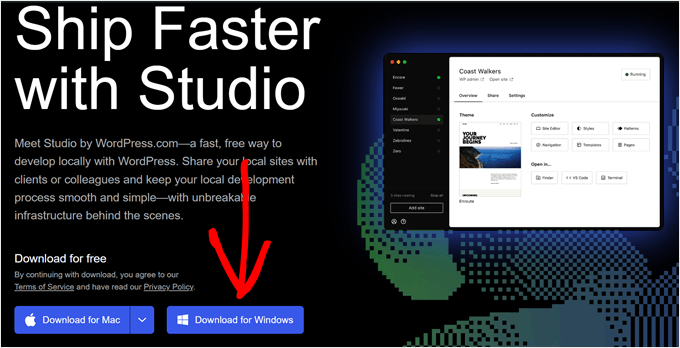
Una vez hecho esto, sólo tienes que abrir el archivo descargado para iniciar la instalación.
Aparecerá una ventana emergente que le indicará que se está instalando la aplicación.
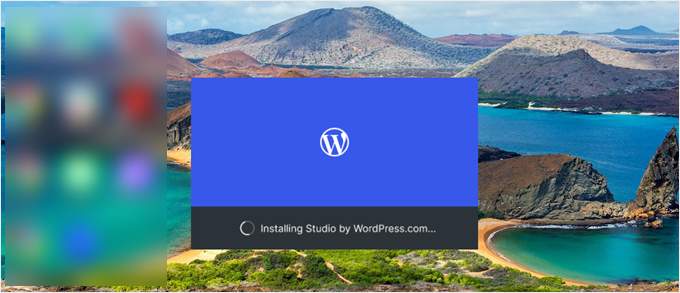
Una vez hecho esto, puede añadir su primer sitio.
Para ello, introduce el nombre de tu nuevo sitio local de WordPress y haz clic en “Añadir sitio”. Puedes nombrar el sitio como quieras siempre que te ayude a identificarlo fácilmente.
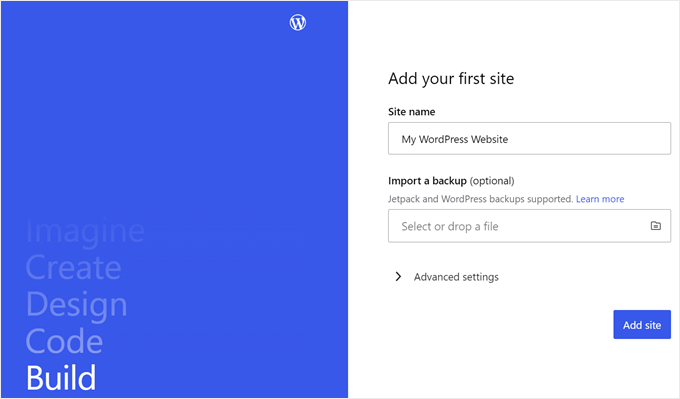
Ahora debería ver el escritorio de WordPress local.
Para acceder a tu escritorio de WordPress y editar tu sitio web, sólo tienes que hacer clic en el botón “Inicio” situado en la esquina superior derecha. De este modo, podrá acceder a su sitio web local desde su ordenador.
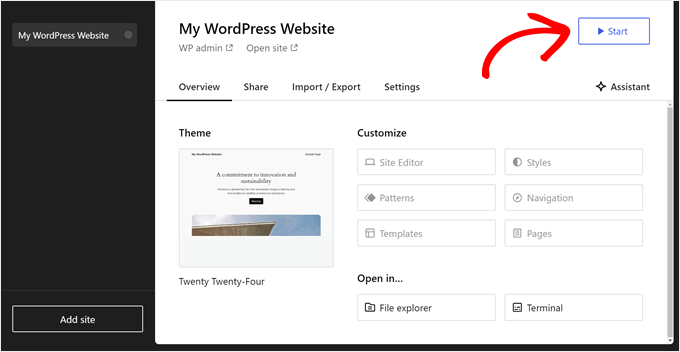
Una vez que el botón “Iniciar” cambie a “Ejecutando”, puede hacer clic en el enlace “WP Admin” en la parte superior izquierda de la página.
Esto le llevará a su página local de administración de WordPress.
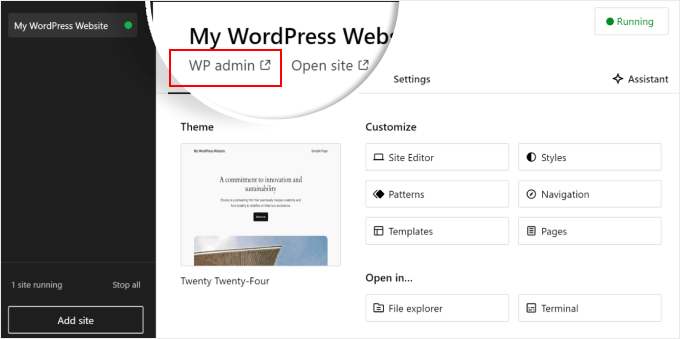
Y eso es más o menos todo para la configuración. Vamos a explorar los otros ajustes que pueden ser necesarios a medida que construye su sitio web local.
Como puedes ver en la pestaña ‘Visión general’, puedes acceder inmediatamente al menú completo del editor de WordPress directamente desde el escritorio de Studio. También puedes hacer clic en “Explorador de archivos” para abrir las carpetas y archivos de tu sitio web de WordPress y hacer clic en “Terminal” para administrar tu sitio web mediante WP-CLI.
Si cambias a la pestaña “Compartir”, puedes acceder a tu cuenta de WordPress.com, clonar tu sitio web local y subirlo a los servidores de WordPress.com. Esto hará que el sitio clonado esté online temporalmente, lo que resulta útil para compartir sitios de demostración con tus clientes o miembros del equipo.
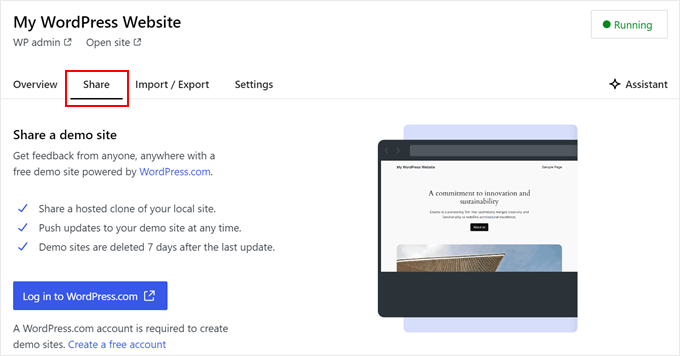
A veces, es posible que desee iniciar sesión en su sitio web local directamente a través de su navegador en lugar de utilizar Studio. En ese caso, necesita conocer sus credenciales de wp-admin.
Para encontrarlos, puede cambiar a la pestaña “Configuración” y encontrar allí su nombre de usuario, contraseña y URL de inicio de sesión de administrador de WordPress.
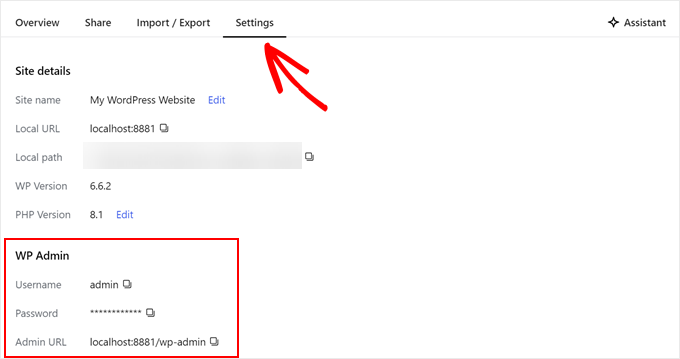
Otra característica interesante de Studio es su chatbot de inteligencia artificial integrado, con el que puedes comunicarte pulsando el botón “Asistente”.
Aquí puedes pedir ayuda a Studio para tareas como actualizar todos tus plugins a la vez, actualizar la versión principal de WordPress o crear código para un bloque personalizado.
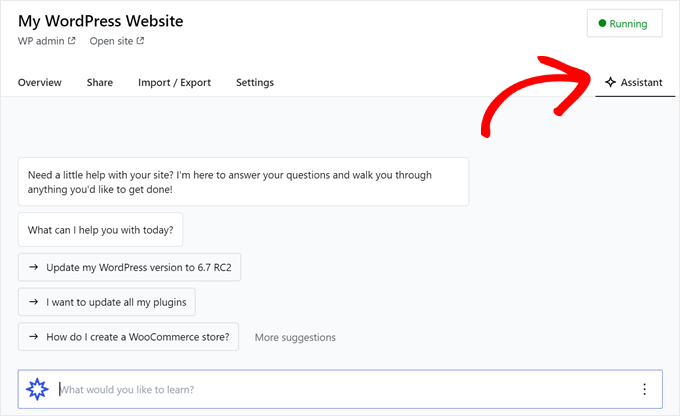
Cuando hayas terminado de trabajar en tu sitio local, sólo tienes que pasar el ratón por encima del botón “En ejecución” de la esquina superior derecha hasta que ponga “Detener”.
A continuación, haga clic en el botón para detener el sitio web.
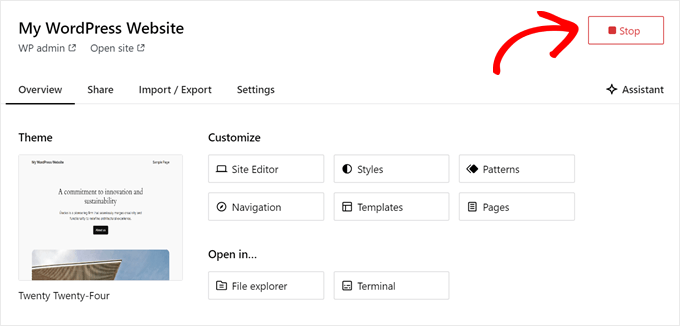
Una desventaja de Studio es que no puedes configurar el entorno de WordPress a tu gusto. Esto significa que tienes que utilizar la versión de PHP, el servidor web y la base de datos que se han preseleccionado para ti.
Esto puede ser un inconveniente si necesitas probar tu sitio web o plugin con configuraciones de servidor específicas.
Si necesita un mayor control sobre su entorno local de WordPress o necesita que su configuración local coincida con una configuración específica del servidor en vivo, entonces puede consultar el siguiente método usando WP Local.
Método 2: Instalar WordPress en Windows Usando WP Local (Más Personalizable)
En primer lugar, debe descargar e instalar el software Local WP en su ordenador Windows. Simplemente vaya al sitio web de Local WP y haga clic en el botón “Descargar gratis”.
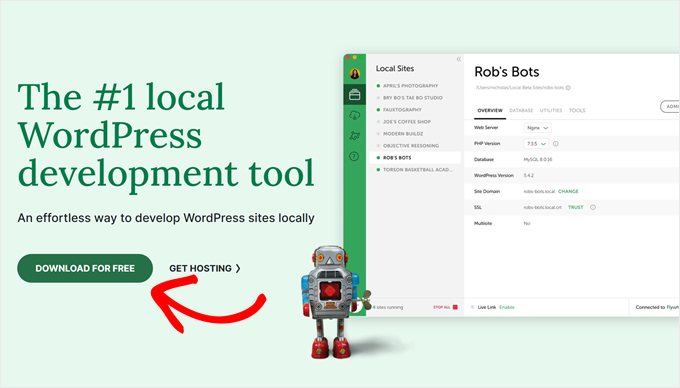
A continuación, aparecerá una ventana emergente en la que tendrás que seleccionar tu plataforma. Elige “Windows” en el menú desplegable.
A continuación, puedes introducir tus datos, como nombre y apellidos, dirección de correo electrónico laboral y número de teléfono, para descargar el software.
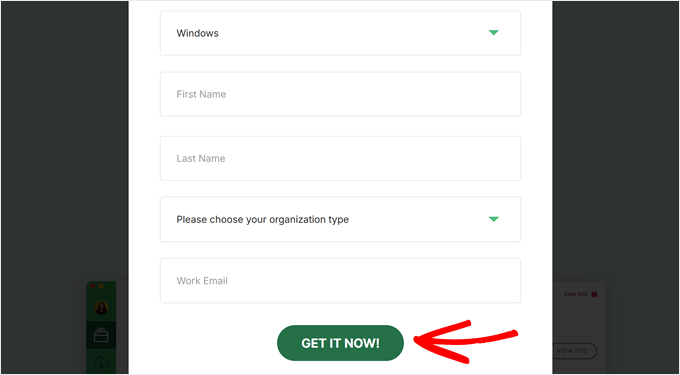
Una vez introducidos los datos, basta con hacer clic en el botón “Consíguelo ahora”.
A continuación, el software se descargará automáticamente en tu ordenador. De lo contrario, puede hacer clic en el enlace “haga clic aquí” para iniciar la descarga.
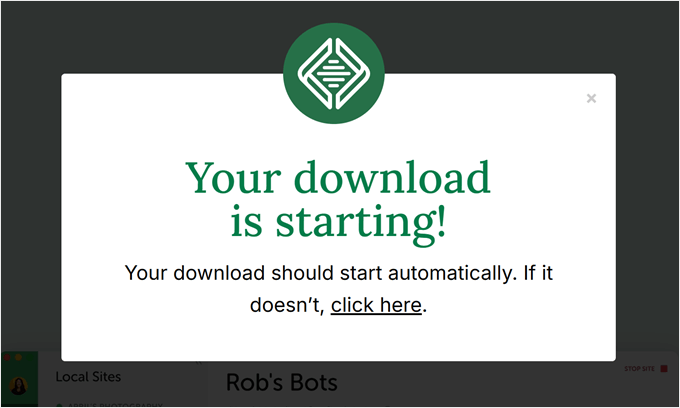
Una vez descargado el archivo, inicie el asistente de instalación.
Ahora, tendrás que seleccionar si quieres instalar el software para todos los usuarios o sólo para ti.
Una vez seleccionada una opción, pulse el botón “Siguiente”.
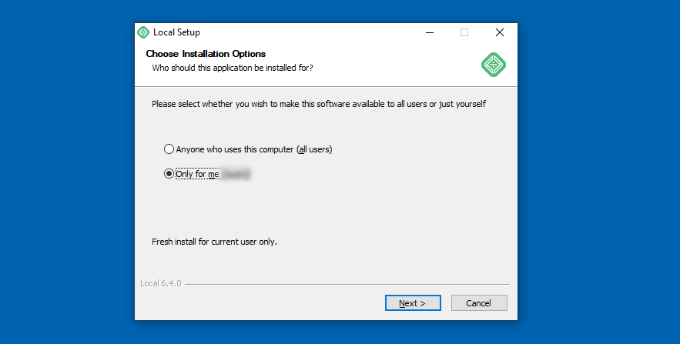
En el siguiente paso, puede seleccionar la “Carpeta de destino” donde se instalará el software.
Basta con hacer clic en el botón “Examinar” para establecer la ruta y, a continuación, hacer clic en el botón “Instalar”.
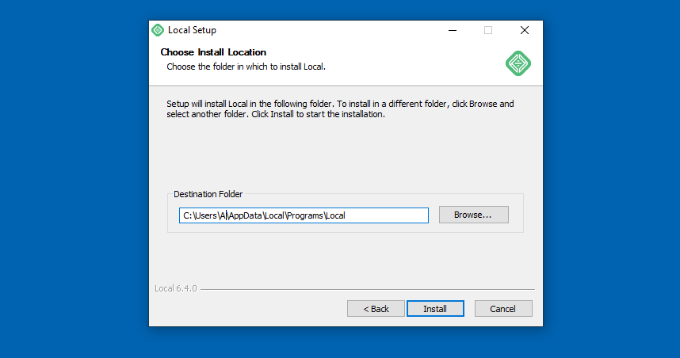
El software Local WP se instalará en tu ordenador Windows.
Una vez hecho esto, puede marcar / comprobar la casilla de verificación “Ejecutar localmente” y hacer clic en el botón “Finalizar” del asistente de configuración.
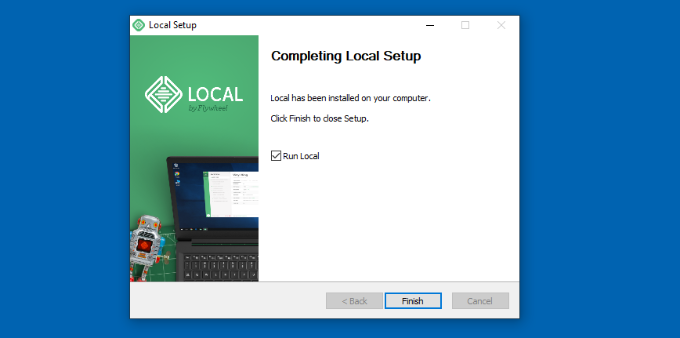
El software se iniciará ahora en su dispositivo Windows.
El siguiente paso es añadir un nuevo sitio web local. Para ello, basta con hacer clic en el botón “+” de la parte inferior.
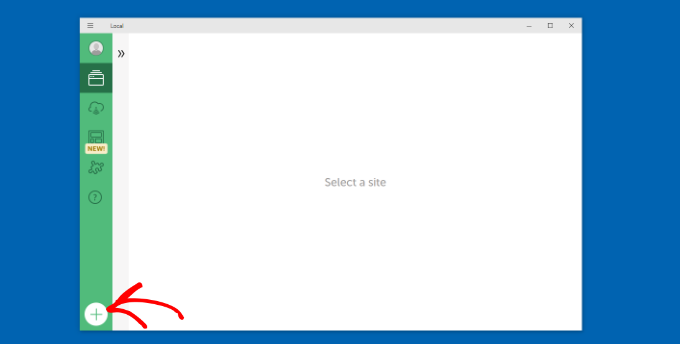
Después, puede crear un sitio en el software Local.
Seleccione la opción “Crear un nuevo sitio” y haga clic en el botón “Continuar”. También hay opciones para crear el sitio desde un plano o un archivo de sitio web existente, pero vamos a ir con la primera opción en aras de la demostración.
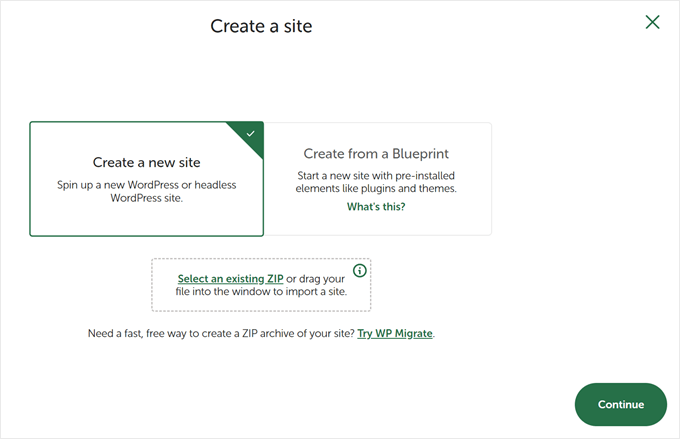
A continuación, puede introducir un nombre para su sitio web local, como “Mi sitio web WordPress”.
También hay opciones avanzadas en las que puede introducir el dominio del sitio local y la ruta del sitio local. Por defecto, el dominio utilizará el título de su sitio web, pero separado por guiones.
Una vez que haya terminado, simplemente haga clic en el botón “Continuar”.
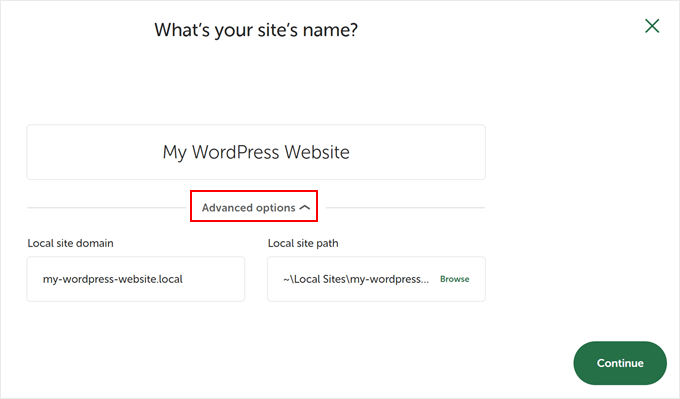
Después, tendrá que elegir un entorno para su sitio web local.
Puede utilizar el entorno ‘Preferido’, en el que el software seleccionará automáticamente la versión de PHP, el servidor web y la versión de MySQL. Por otro lado, también puedes seleccionar ‘Personalizado’ e introducir los detalles del entorno.
Local WP ofrece las últimas versiones de PHP. En cuanto al servidor web, puedes elegir entre Nginx o Apache. También puedes seleccionar entre MySQL o MariaDB para las bases de datos.
Tenga en cuenta que algunas versiones de PHP, servidores web y bases de datos requieren la descarga de algunas dependencias para que funcionen correctamente.
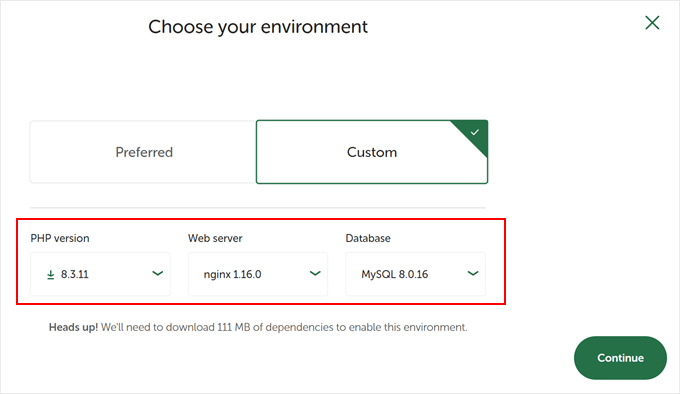
A continuación, puedes introducir un nombre de usuario y una contraseña de WordPress para tu sitio web local. Además, también tienes la opción de elegir una dirección de correo electrónico de WordPress en la que recibirás todas las notificaciones por correo electrónico.
Aparte de eso, hay una opción avanzada en la que el programa te preguntará si tienes una red multisitio de WordPress. Si no es así, haz clic en “No”.
Tras introducir estos datos, basta con hacer clic en el botón “Añadir sitio”.
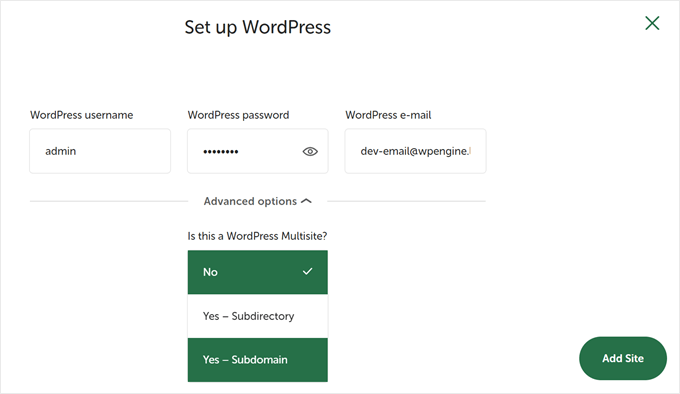
El programa instalará WordPress y establecerá su sitio web.
Para iniciar el sitio web local, haz clic en el botón “Iniciar sitio” situado en la esquina superior derecha.
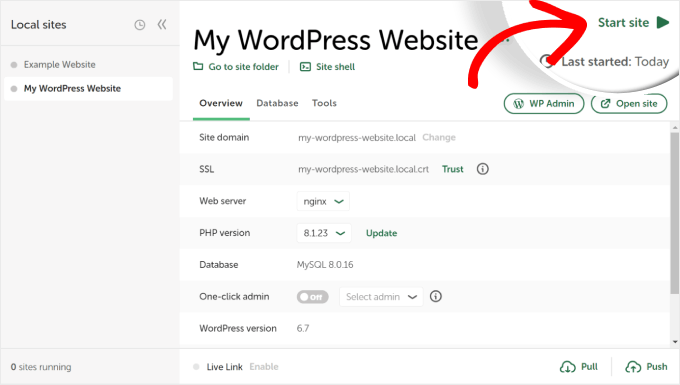
A continuación, haz clic en el botón “WP Admin” y verás la página de inicio de sesión del administrador de WordPress.
Sólo tiene que introducir el nombre de usuario y la contraseña que introdujo anteriormente al configurar el sitio web local y, a continuación, hacer clic en el botón “Iniciar sesión”.
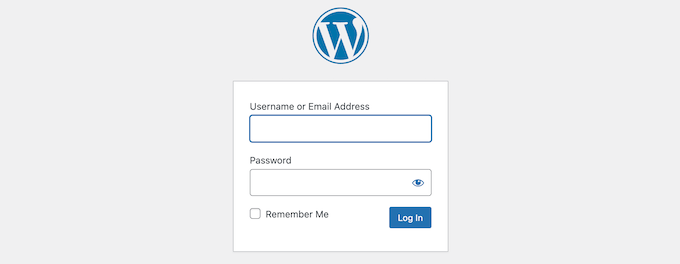
Ahora puede editar su sitio web local en su ordenador Windows.
Cuando haya terminado, no olvide detener el sitio web desde el software WP local al hacer clic en el botón “Detener sitio”.
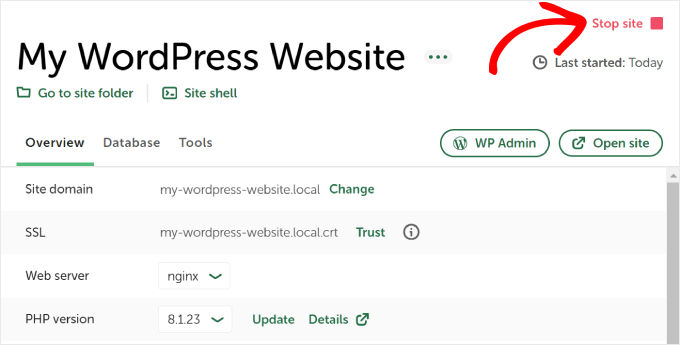
Consejo profesional: Si desea omitir el proceso de inicio de sesión, puede habilitar un inicio de sesión de administrador con un solo clic en Local WP.
Para ello, vuelve al panel de control de Local WP y activa el botón “One-click admin” hasta que aparezca “On”. A continuación, en el menú desplegable, seleccione el usuario administrador que puede utilizar esta función de inicio de sesión con un solo clic.
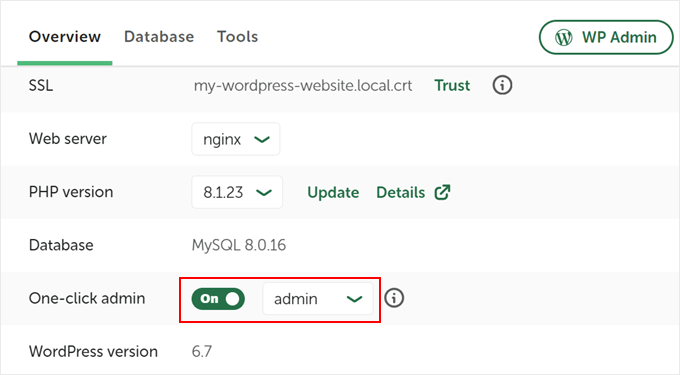
Alternativa: Utiliza WordPress Playground para probar temas, plugins y mucho más
WordPress Playground es una herramienta innovadora que te permite experimentar con WordPress directamente en tu navegador web. Es una caja de arena virtual donde puedes probar nuevos temas, plugins y funciones de WordPress sin afectar a ningún sitio web real.
WordPress Playground difiere de un entorno local de WordPress en varios aspectos clave.
En primer lugar, no requiere instalación en tu ordenador y se reinicia después de cada uso, a diferencia de las instalaciones locales permanentes. Puedes acceder a ella desde cualquier dispositivo con un navegador, mientras que las instalaciones locales están atadas a un ordenador.
Mientras que WordPress Playground es ideal para pruebas rápidas y aprendizaje, un entorno local de WordPress en su ordenador Windows ofrece más flexibilidad para proyectos de desarrollo a largo plazo.
Para obtener información detallada, consulte nuestra guía sobre cómo utilizar WordPress Playground en su navegador.
He instalado WordPress en mi ordenador Windows, ¿y ahora qué?
Ahora que ya tienes WordPress en tu ordenador, aquí tienes algunas cosas que puedes hacer:
- Aprenda trucos y consejos básicos de WordPress para utilizar mejor su sitio.
- Pruebe diferentes temas de WordPress para ver cómo puede quedar su sitio.
- Instale y pruebe los plugins imprescindibles de WordPress para añadir nuevas funciones a su sitio.
- Aprenda a solucionar errores comunes de WordPress por su cuenta.
- Pruebe diferentes creadores de páginas de arrastrar y soltar para que su sitio tenga un aspecto atractivo.
- Aprenda a restablecer la contraseña de administrador de WordPress en localhost para recuperar el acceso a su sitio.
- Establezca flujos de trabajo automatizados para facilitar la gestión de su sitio.
- Infórmese sobre la seguridad de WordPress para mantener su sitio a salvo de los piratas informáticos.
- Traslade su sitio local de WordPress a un servidor activo cuando esté listo para compartirlo con todo el mundo.
Esperamos que este artículo te haya ayudado a aprender cómo instalar WordPress localmente en un ordenador con Windows. Puede que también quieras ver nuestro artículo sobre cómo instalar WordPress localmente en un ordenador Mac y nuestra guía definitiva para crear un sitio de prueba de WordPress.
If you liked this article, then please subscribe to our YouTube Channel for WordPress video tutorials. You can also find us on Twitter and Facebook.




Bidyut Kumar Mondal
Thanks a lot for such a wonderful post.
Ali
Just to say Thank you very much.
sreenu
thank you…thank you soooooooooooo much ..
Nissim
Thank you so much. this was sterling
adriana
OMG i made it through. lol. thank you for your time writing this, it helped me through the panic stage lol
mahendra
Who help of peoples, They are God
Kenneth Ekeh
Help please! I have followed the article and installed wamp, created the wp database but culd not be able to run complete configuration of wp. Its telling me “can’t select database”. Try Again. Please help me to fix this. Thanks.
WPBeginner Support
During the installation when it asks for your database details, please make sure that you are entering the same name for the database which you used when creating database in phpmyadmin. For username, use root and leave password blank.
Admin
Tom
Upon opening mysql workbench, choose your connection, then write the code without quotes “create database nameofyourdatabase;” this will be the name of your database and what you will use in the wordpress setup when it asks for the name of your 1)database(use nameofyourdatabase) 2)username 3)password 4)database host(im using “localhost”)
Hope this helps.
Tammi L. Coles
Just a quick note of thanks for this very simple-to-follow tutorial. It worked like a charm (including the Apache rewrite for permalinks follow-up).
ogunmakinwa dayohanks.
Your tutorials as been good for me so far, but please which stable wordpress can i download? can i download the latest version? i am just thinking that some plugins might not be available for the latest version.. so for now which version do you recommend for me? thanks
WPBeginner Support
We always recommend using the latest stable version of WordPress.
Admin
Mohamed Ishag
Hi there,
Would you please answer the question posted on 12/11/13 I still need help
as I am unable to run the WAMP Server on Windos 8. Please read question posted on 12/11/13.
Thank you in advance.
Regards,
Mohamed
Orestes
I was able to install WP, but I’d like to know how to manage different web logs within my local server. Thank you for the instructions and tutorials here.
WPBeginner Support
you can install different weblogs (blogs or websites) on the same server by installing wordpress in different sub-directories inside your
/wamp/wwwfolder. For example:C:\wamp\www\site-1 will open in http://localhost/site-1
C:\wamp\www\site-2 will open in http://localhost/site-2
Admin
GinoDC
After entering details for Site Title, Username, Password and Email I press Install WordPress and my computer hangs. Please help.
WPBeginner Support
This could happen for a number of reasons. Try to uninstall wampserver and then download and reinstall again. If the problem presists, then you can try XAMPP.
Admin
Mohamed Ishag
Hello,
I have installed WAMP on Windows 8 but I am having a problem creating a data base due to the following error (You don’t have permission to access /phpmyadmin/ on this server). I have edited the htpd.conf file as follows
Open file httpd.conf through wamp tray icon
Find:
# onlineoffline tag – don’t remove
Order Deny,Allow
Deny from all
Allow from 127.0.0.1
Change to:
# onlineoffline tag – don’t remove
Order Deny,Allow
Allow from all
Then saved but still get the same error, why!? Norton 360 is installed on the PC
and no other conflicting apps. I need some help to fix this issue. Any ideas? Thank you in advance.
Best Regards,
Mohamed
Mohamed Ishag
Dear Syed and the team,
Thank you very much for this site. I am new to WordPress and found your tutorials and explanation very good and straight forward. I feel that you are a busy man but still have time to dedicate this site to new WP beginners. God bless your parents.
Salam,
Mohamed
adam
Hello,
I have installed everything and am finally at my wordpress dashboard on my localhost machine. everytime i click on visit my site to view what I have changed the page simple directs to the WAMP server configuration screen that shows apache version, php version, loaded extensions, etc… It seems that something simple needs to be changed but I dont know…Can anyone please help? Thanks in advance…
WPBeginner Support
You have probably installed WordPress in www directory. You need to install it in a subdirectory like www/testsite1/
Admin
Nuno
Hey i have the same problem, so if i just copy all the files to a subdirectory it will work or do i have to reinstall it all over? Thanks.
Matthew
Thank you, than you, thank you. I am a technophobe and your clear instructions helped me all the way.
Arthur
Hi,
After installing WAMP in accordance with your instructions, I could not open phpmyadmin; explorer kept waiting for localhost. I’m not a pc techie so I desperately need instructions how to proceed furter in the same easy way as your manual above. I have a 64 bit W7 machine, and installed the 64 bit version of WAMP first, but since that did not work as described , I installed the 32 bit, but with the same result. Thanks for your help in advance ! (No Skype, port 80 OK, as far as I can see)
WPBeginner Support
Try restarting all services make sure that WAMPServer icon is green also make sure that Skype is not running in the background. Also look at this support thread for more possible solutions.
Admin
Arthur
Thanks a lot: I followed your recommended thread and I removed a double line in the Host file (‘127.0.0.1 Localhost’) that seemed too much and now I can get to a log-in page of phpMyAdmin, which is great, but I have not yet even entered an ID and password during initial installation of WAMP. Did I miss something ?
Thanks for your patience again…
WPBeginner Support
To log in to phpMyAdmin, enter username root and leave password blank.
Trudy Ritsema
Can I run more than 1 test site on WAMP? and any ideas of how I would go about this please?
I already I have localhost site running – and I don’t want to get rid of that yet as I am still developing it…
Thanks in advance.
WPBeginner Support
in your www directory create new directories for each website. That way you can run multiple sites on localhost.
Admin
viki
i can’t create new database, bcause it is showing ” * No Privileges” in red colour letters. please help me
WPBeginner Support
you are probably entering wrong credentials to connect to your mysql database.
Admin
nick mav
you should login using the following credentials:
username: root
password: [empty] –> that is, no password
Shawn Morrissey
Thanks Nick,
I had the same issue and couldn’t find this out anywhere I had looked previously…
SanketP
Hi. I am a new-bee to this world of eb designing. Wanted Joomla but that didnot go thru too well. WP instal was as good for me. Thank you. XOXOXO.
Everett
Hello. I want to be able to develop my wordpress site locally and not have to be connected to the web when I make changes and do save or update inside wordpress. Before I go through all the installation of WAMP and WP locally, can anyone tell me if I will have to have internet access to make updates to a wordpress running locally in WAMP? Sure I realize if I wanted a new Theme or Plugin, I would have to be online, but if I am just making adjustments to text and adding pictures that are already on my laptop, etc. will I have to have internet access to do so? I ask because I do a lot of travel where I am on an airplane and could be working on a new version of a website if I don’t have to be online. Also, I can’t afford a wireless account for my laptop, so I only have internet when I am at home with my own wifi or when I am somewhere that has a free wifi. Thanks.
WPBeginner Support
no you do not need an internet connection to work locally on your website.
Admin
Ian
I followed the instructions to the letter, installed WAMP and the required SP1 Visual C++ on a brand new laptop running Windows 8 64bit. The installation refuses to launch, brings up a screen asking if I’m sure I want to let this programme make changes to the computer, then does nothing when ‘Yes’ is clicked. What is going wrong?
WPBeginner Support
Does the wampserver icon appear in your windows taskbar? If it does, then you need to click it and launch wampserver.
Admin
Brynn
Please help. I installed WAMP but when I went to open phphMyAdmin, nothing happens. I tried uninstalling and reinstalling, but still getting the same problem. I’m not even getting any sort of popup block notification in my browser. Just nothing.
I wonder if this might have something to do with the WARNING window that popped up on the WAMP website before I downloaded it… It said something in French, and then something about needing to install C++ which I know nothing about, and which was not mentioned in this tutorial.
Do I need to install C++ and if so, do I need to learn how to use the programming language before I can finish this tutorial on installing WordPress? I am a designer, not a programmer, so I hope to god I don’t need to stop everything and go learn C++ before I can do a simple WordPress install.
WPBeginner Support
Brynn you can always check whether or not Microsoft Visual C++ is installed on your computer from Control Panel -> Programs and Features. Do you see wampserver page when you visit http://localhost? If you do, then you have already successfully installed WAMP.
John Victor
Can I hug you now or later?
Anudeep
Awesome tutorial
guru
I install wordpress to my localhost. But i dont know to use it to develop a site. I’m new to wordpress. Please anyone help me.
WPBeginner Support
Take a look at our beginner’s guide section. For theme development you may want to take a look at our WordPress theme cheat sheet for beginners.
Admin
Scott Cho
Got WAMP installed, but when I try to create a new databse by clicking on the phpMyAdmin button in WAMP the chrome browser window that opens up says:
Forbidden
You don’t have permission to access /phpmyadmin/ on this server.
Can anyone point me in the right direction as to what this is and how to fix it? I don’t know if this makes a difference but I have it installed on my secondary hard drive, not my C drive (the c drive just has my operating system).
Asad Riaz
Here is how you edit the htpd.conf file
Open file httpd.conf through wamp tray icon
Find:
# onlineoffline tag – don’t remove
Order Deny,Allow
Deny from all
Allow from 127.0.0.1
Change to:
# onlineoffline tag – don’t remove
Order Deny,Allow
Allow from all
Plus resolution to some other conflicts
Make sure no other program conflict wamp such as Xampp, phpEasy, IIS, Skype, Zonealarm, firewall/antivirus, NOD32, Eset, any web and/or Remote Desktop related program, such as Teamviewer …
IIS and Apache/Wamp are both web server and might conflict in some way, so you have to disable IIS in order for Wamp to work
Disable IIS in Vista/W7:
Control Panel, Uninstall Programs, Turn Widows Features On or Off, uncheck Internet Information Services
Disable IIS in XP:
Control Panel, Add/Remove Programs, Add/Remove Windows Components, uncheck Internet Information Services (IIS)
Restart computer, then restart Wamp
Also, in folder C:\WINDOWS\System32\drivers\etc, open file hosts and delete anything in this file and have only this line below and nothing else
127.0.0.1 localhost
If using Skype, go to Tools->Options->Advanced->Connection and uncheck the box “Use 80 and 443 as alternatives for incoming connections”. Restart Skype after WAMP. Now you will be able to use both programs at the same time w/o problems.
I hope it helps, found it on net
Asad Riaz
Howdy,
Well i have managed to install it using the article. Some info was missing in this article like
1. Once you click on phpMyAdmin, it asks for login details, so here they are:
username: root
pass: (leave it blank)
2. WAMP sometimes gets offline and it wont open the phpMyAdmin page, so you guys need to edit the htpd.conf file in C:wamp/bin/apache4.2/conf/htpd
Lets see now how much it helps me.
I m here for all the support that i can extend.
Thanks to the author of this page.
Cesar M.
thanks for the user info I was getting crazy, but I finally got in to phpmyadmin
Colin Teasdale
Hiya,
Problem solved – I had needed to install the Visual C# redistributable, and did that after installing Winamp. Uninstalled Winamp, rebooted and then re-installed – everything fine. That’ll be user error then ! ! !
Colin T.
Scott Cho
I’m getting the same error you just described below, where is this redistributable you speak of?
Colin Teasdale
Hi guys,
I’ve just downloaded and installed WAMP and have got to the “set up a database” stage. When I select ‘phpMyAdmin’ I get a ‘Firefox Problem Loading Page’ page with “Unable to connect – Firefox can’t establish a connection to the server at localhost”.
I’ve tried the fix suggested by Imran on June 17th, but this doesn’t seem to have fixed resolved the problem.
Any thoughts on how I fix this, please??
Peter
Hi Editorial Staff,
Do you have a tutorial that is the reverse process also using WAMP? I have a functioning website that I would like to duplicate on my home computer for experimenting and learning css, and php programming without risking my functional website.
Thanks.
EL
That is exactly what I need!
Denzil
Hi, a very useful article, thanks. Is it easy to migrate a test WP site on WAMP to a hosted site elsewhere? Do you have a tutorial article to help?
Thanks
Editorial Staff
Yes, it is fairly easy to do that. Tutorial will be coming tomorrow
Admin
Denzil
Great! How timely! Thanks guys, looking forward to it.
Kate BP
Absolutely cracking article – really helpful, thanks so much!
akash
After clicking on phpmyadmin,,,,,,,
i am getting redirected to directly php my admin webpage and not the database entry option which is shown above.
thereafter the details are not matching afterwards in database,username and password.please give me its solution as soon as psbl.
Amitoj Gautam
User Name: Root
Password: None (Leave this space empty)
Click on the Go button. You will be directed to the page you are looking for.
Dana
Hi! Once I’ve created a site on my WAMP server, could I then transfer it to an existing domain name? I’m trying to create a new site without shutting down the old one. Once the new one is finished, I would want to replace the old one, but use the same domain name. Thank you!
Editorial Staff
Yes you can do that. We have updated the article to add a link to the tutorial.
Admin
vahid
Thank you so much
chris martin
Hi, I am having trouble with links not working. Could you help me or give me some direction on how to fix that? On my site “chrisjamesmedia.com” click menu, then “blog” and i get “not found”. This also happens with links as well.
Also, do you have a tutorial on how to host multiple domains from this as well, or point me in the right direction.? I have looked up several things about virtual domain, localhost, and everytime I find something they want me to edit httpd conf, but what they have doesnt match mine.
Thank you so much!!!!
Tamsin
Hi,
Great article, very clearly explained.
Would you be able to tell me the best way to add a second WordPress site to Wamp? I have read a lot of conflicting information and would rather not make a massive mess of things!
Editorial Staff
Create a new folder inside your www folder, then repeat this process.
Admin
Tom Smith
Hi,
Thank you for providing this excellent tutorial! It’s going to be great to get use to using WP onn my PC before I install it on my host server and create my website.
I followed your instructions and installed WAMP and then WordPress and got all the screens you showed here… and with the tweaking you suggested, I was finally able to open WP – saw the Dashboard, etc. Then I closed it.
But now I can’t seem to open WP. I open WAMP and click on Localhost – and it just sits “waiting for response from localhost” – does not open anything. I’ve tried http://localhost/my database name – it will not open – I get “HTTP 500 Internal Server Error”. Just in case, I also followed your instructions on SKYPE and unchecked that Port 80 box.
What am I missing?
Editorial Staff
Did you shut down your computer? You have to launch WAMP Server every time you restart your computer.
Admin
Imran
When i try to Setting Up a Database for WordPress, it was saying like this : Forbidden
You don’t have permission to access /phpmyadmin/ on this server. what is the reason ? can you please guide me. thank you in advance….
Editorial Staff
That’s weird. Since you are the admin of your Wamp install, then you shouldn’t get this error.
Admin
Imran
Finally i got the solution…
I think it will be useful for others.
for phpmyadmin
Goto c : wamp/alias/phpmyadmin.conf file, open with notepad.
find
Options Indexes FollowSymLinks MultiViews
AllowOverride all
Order Deny,Allow
Deny from all
Allow from 127.0.0.1
replace with
Options Indexes FollowSymLinks MultiViews
AllowOverride all
Order Deny,Allow
Allow from all
thats it…
Imran
Thank you very much EDITORIAL STAFF, this is a nice post and very usefull.
Melanie
I had this same problem with the phpmyadmin and I found and made the changes cited here to the alias file, then restarted WAMP and I was able to create my database. However, now I’m getting the same Forbidden message when I try to install WordPress on my localhost, exact text below:
Forbidden
You don’t have permission to access / on this server.
I can get to the WP install screen from 127.0.0.1, but not localhost. I’m running Windows 8. Any ideas on how to get this to install? Thanks in advance for any help you might be able to give me.
Akshay
Hi.
I wanted to use this method to test out plugins before installing then on my live site. So in your tutorial, instead of copying in clean WordPress files, I copied in a full backup of my site made using BackupBuddy.
However from this point on I’m not sure what to modify in order for my site to function correctly offline. I edited my wp-config file to the new database details, and imported my database from my online phpmyadmin to the WAMP one. However it seems like there’s something I’m missing, as when I try to access localhost/site/wp-admin I am redirected to my online login page.
Do you have any suggestions?
Thanks very much for your help.
Akshay
Brandi
I’m in the same boat – did you ever find a solutions?
Christophe R.
Another (lazy) point for XAMPP : I know there are some differences in the config files, but I use both linux (at home) and Windows (Seven and 8) at work, so I appreciate having the same interface for I only have to learn once.
Andre
Great article and easy instructions for those who want to venture into WAMPP….however, for myself, I still prefer XAMPP and do run it on it’s own on a second drive without the installable version. Updating is a breeze, although I rarely need to.
I’ve used XAMPP for many years now for both WordPress and Joomla theme development, as well for a testing server. Never had issues and I do find it quite easy to use. I used to use the full version but I found that the Lite version works extremely well.
I noticed someone said AMPPS, but I’ve never tried that…perhaps in my spare time I will try it out.
Nicholas
Its click and install that’s how easy it is and just open to localhost/ampps i use it for all my scripts that this includes as downloads and install on the service. no worries on xamp and wamp that i found to limited in some ways.
Adrian
Thanks alot it was really helpful
Thomas
Hi everyone,
I’m a very beginner with WordPress and I have created a site with it and WAMP on my computer.
Now I want to put it online, but I don’t know how to do it.
Where does a tutorial exist for that?
The thing is that I want to replace the current site, which is hosted somewhere else, and so keeping the domain name.
Does anyone know where I can find this kind of information?
Thanks a lot!
Nicholas
WAMP in the older days was great! Now there is a far more better and less embarrassing way when it comes to configuring things with WAMP. WAMP is in the past and gone for me. I use AMPPS far more better no configurations, just install and a few dips of changes in the options section that’s it. Open your browser go to your localhost and install any cms or other scripting lang within your browser using ampps. You’ll be amazed! No more downloading then extracting in www folder and then reconfiguring. WordPress is just a click and install on ampps. No hassle! Shouldn’t you guys write something about AMPPS? This is a lot more better than WAMP! WAMP lags a lot of things like cgi and stuff those are extras, but on ampps everything is included. Ever since ampps I never looked back to wamp! Sorry!
Editorial Staff
Have been using WAMP for so long that didn’t even bother with another option. AMPPS sure looks good. Good to see that it is made by the folks from Softaculous. Will have to give it a try.
Thanks for the suggestion Nicholas.
Admin
Zimbrul
Why do you say you prefer WAMP over XAMPP?
Alexander Gounder
WAMP is much simpler and easier to use compared to XAMPP.
Editorial Staff
Would second that. WAMP is easier to use. Several years ago when we used XAMPP the upgrade process was complicated and it was buggy. We switched over to WAMP and it was awesome.
Admin
Parth S.
Hi, Thank you very much for this. It’s very informative and easy to follow. However I’d suggest you mention the skype thing a lil early around the localhost point, because, there ppl start to worry when they see a blank screen with skype on in their PC.
Great post though. Keep it up.
Mladen
Just to mention, that Team Viewer also causes problems with WAMP.
Christophe R.
I actually do prefer XAMPP and DTX-Control for I can overcome security policy : Installation without administration rights (zip file pour the web server) and full access to blocked ports (80, 443, 3306).